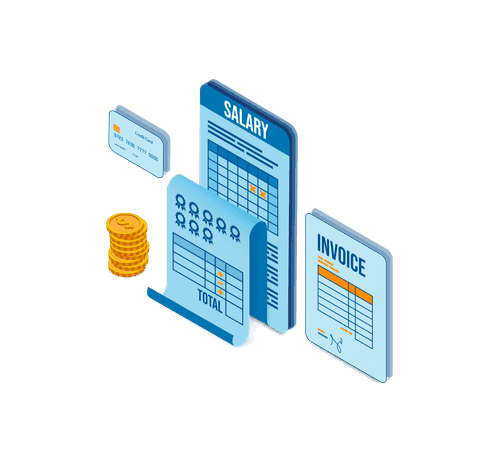Payroll Process Explained
Payroll accounting, as a part of HR management, is a fundamental component of employee management and requires monthly effort for HR managers. The level of effort required largely depends on the software used and whether clear processes have been established. In any case, one thing is clear: payroll accounting should ideally be error-free.

Preparatory Payroll Accounting
The difference between preparatory payroll accounting and payroll accounting lies in their respective roles and timing within the payroll process.
Preparatory payroll accounting refers to the process that occurs before the actual creation of the final payroll statements. It involves the collection, verification, and preparation of wage-related data and information. During this stage, employee data is collected, working hours are recorded, salary and wage calculations are made, and potential errors or discrepancies are identified. The purpose of preparatory payroll accounting is to ensure that the data is accurate before the final payroll statements are generated.
Preparatory payroll accounting, therefore, represents a part of wage data processing that takes place before the actual creation of payroll statements. It includes the collection, verification, and preparation of wage-related data. In contrast, payroll accounting encompasses the entire process of managing and calculating wages and salaries, including data collection, calculations, documentation, and wage distribution.
Payroll Accounting: A Definition
Payroll accounting is an essential part of corporate accounting that deals specifically with the management and calculation of wages and salaries within a company. This area includes the collection, calculation, accounting, and documentation of all wage-related employee data.
The basis: Complete employee master data, such as name, address, social security number, and tax class. On top of that comes variable data, such as information on working hours, overtime, vacation days, and absences. The result is a correct calculation of wages. Payroll accounting also involves communication with authorities, compliance with legal regulations, and the payment of contributions to health insurance and tax authorities.
Payroll accounting, therefore, results in the calculation of gross and net wages or salaries for all employees for a specific period, typically on a monthly basis, and includes the associated wage or salary costs and related social expenses.
What Is the Difference Between Wage and Salary?
Although the terms Wage and salary are often treated as synonyms, if we look more closely, wage often refers to the compensation of employees who do not have a direct employment status. In contrast, salary terminology is typically used for permanent employees.
Wage Wage generally refers to the remuneration of employees based on hours worked and is usually calculated and paid on an hourly, daily, weekly, or monthly basis. Employees in areas such as production, craftsmanship, or services typically receive an hourly wage or performance-based compensation. It can also include variable components such as overtime pay or performance bonuses.
Salary In contrast, there is salary, which generally refers to the compensation of employees who are employed in a specific position or function. Salary is typically paid on a monthly basis and is based on a fixed, agreed-upon amount per month or year, regardless of the actual working hours. It is not directly related to working hours. Salaried employees often receive additional benefits such as holiday pay, Christmas bonuses, or company pensions, which can be included in their salary.
Retention Periods in Payroll Accounting
Retention periods for payroll accounting data may vary depending on legal regulations in different countries. The main retention periods typically range from 6 to 10 years.
6 years retention period:
- Wage records
- Timekeeping records
- Travel logs
- Expense reports
- Tax exemption certificates
10 years retention period:
- Payroll lists
- Payroll receipts
- Payroll tax returns
- Receipts for wages (if paid in cash)
Creating Payroll Accounting: Step by Step
Creating payroll accounting can be a real challenge, especially at the beginning. The following steps are part of the process:
Step 1: Employee Data Collection
Collect relevant employee data, including names, addresses, social security numbers, tax classes, and employment details. Ensure that employee data is correct and up-to-date.
Step 2: Record Working Hours
Record employee working hours, including regular working hours, overtime, vacation days, and other absences. Check the recorded working hours for accuracy and completeness.
Step 3: Wage and Salary Calculation
Calculate employee wages and salaries, considering recorded working hours, hourly rates, allowances, bonuses, and deductions such as taxes and social security contributions. Use applicable legal regulations and collective agreements.
Step 4: Consider Deductions
Account for deductions for taxes, social security contributions, and other mandatory or voluntary deductions. Ensure that deductions are calculated and applied correctly.
Step 5: Include Additional Compensation
Include additional compensation such as holiday pay, Christmas bonuses, bonuses, or other entitlements for employees. Add these amounts to the total compensation.
Step 6: Create Payroll Statements
Based on the preparatory work, create the actual payroll statements for each employee. The payroll statement should detail the base compensation, deductions, additional benefits, and net pay.
Step 7: Review and Correct
Review the created payroll statements for accuracy and completeness. Correct any errors or discrepancies. Thorough checking is essential to ensure the accuracy of payroll statements and avoid potential legal consequences.
Step 8: Wage Disbursement
Pay employees their wages. Ensure that wages are paid on time and in compliance with legal regulations.
Step 9: Retention and Documentation
Store payroll statements and all relevant documents for the required period according to legal regulations.
Challenges in Payroll Accounting
Payroll accounting is comprehensive and involves numerous recurring personnel tasks. Additionally, it deals with sensitive data and is a highly regulated area. As a result, payroll accounting often involves considerable stress before the end of each month.
Challenge 1: Data Completeness and Accuracy
Data is often recorded in Excel spreadsheets, physical folders, or even sticky notes. This means there can be chaos in gathering all relevant data, outdated data, and difficulties in finding the correct information.
Challenge 2: Multiple Isolated Solutions
You may already use specialized tools for storing HR data. Working hours may be tracked in one tool, personnel files stored in another, and absences tracked in a third specialized tool. While this scenario provides clear storage locations for different data sources, it also means collecting different records, often manually, which is prone to errors.
Challenge 3: Information Flow Depends on Individuals
HR managers in your company might have a handle on where different data is stored and how payroll accounting should be prepared. However, it also means that these individuals receive all employee inquiries. This is not only incredibly time-consuming and therefore inefficient but also problematic. What happens if this person is sick, on vacation, or leaves the company?
Payroll Accounting with a Click
All preparatory work, including the processing of master and variable data, is comfortably prepared for monthly payroll accounting. Interfaces to common accounting programs like DATEV Lodas and DATEV Lohn+Gehalt are available, making data transfer straightforward. Finally, there is no more stress at the end of every month!

The Solution: Comprehensive HR Software
The above challenges haven't even taken into account issues related to historical analysis or forecasting future developments. Imagine a scenario where employee data is uniformly stored in a dedicated tool and is continuously self-maintained by employees. This keeps all master data in one place, always up to date, and accessible to everyone.
Working hours, vacations, and sick leaves are all entered into the same tool, where employees manage these details independently. Depending on an approval process, only HR managers have the authority to grant final approval. The result? A Single Source of Truth. As a consequence, the preparatory payroll accounting is completed with just a few clicks and can be easily transferred to DATEV via the interface. Additionally, reports can be generated and analyzed within seconds. The best part: Factors such as minimum wage, time tracking, and absences are automatically considered and transferred in the preparatory payroll accounting.
Disclaimer
We would like to point out that our website provides non-binding information, which under no circumstances constitutes legal advice. This also, and especially, applies to topics within the sphere of legal HR advise. The content of this contribution cannot and is not intended to replace individual and binding legal advice. For this reason, all information provided is without guarantee of correctness and completeness, but always researched with the utmost care.